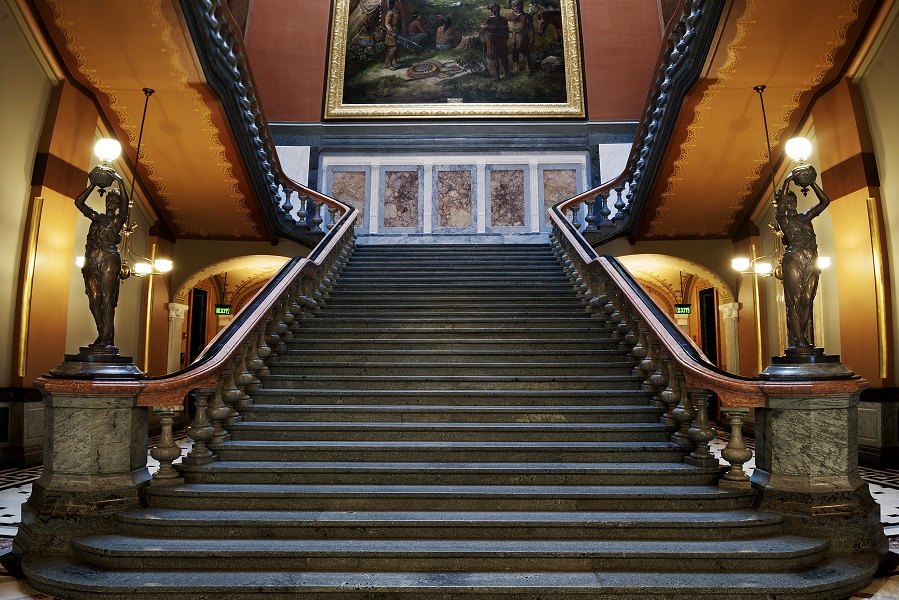Anyone who has visited the Illinois State Capitol in the past couple of years has noticed a lot of construction. The north wing of the Capitol is currently in the midst of a three-year renovation project which will bring the historic building into the 21st century while preserving its 19th century atmosphere and décor.
The current round of renovations follows a complete revamp of the House and Senate chambers back in 2006-2007 and a large-scale rebuild of the west wing of the building in 2011-2012.
It was that west wing renovation which led to the installation of the last part of the architect’s original vision, and which wrote the final chapter of a story still told by tour guides in two different state capitols hundreds of miles apart.

Construction on the current Illinois State Capitol building at 2nd and Monroe – our state’s sixth statehouse, and second in Springfield – began in 1868 after the state outgrew its then-Capitol building at 6th and Adams.
Designed by Chicago architect Alfred Piquenard, the new building would be the tallest domed structure in the United States. It would have enough office space for every agency of state government at the time to find a home. The building’s broad staircases, grand hallways and high ceilings would capture the grandeur of the Gilded Age and would awe visitors and legislators alike.
The centerpiece of Piquenard’s vision was a grand staircase facing the rotunda between the second and third floors, lit from above by a large skylight and from its base by a pair of lamps held aloft by classically-draped female statues which had been manufactured in Piquenard’s native France.
For the most part, Illinois legislators approved of the new Capitol design, but some found the statues too risqué for a late-19th century public building. Finally, the matter was resolved by replacing the statues with plain lampposts at the base of the grand staircase.
Piquenard died in 1876, but his team carried on. The building was constructed enough for state government to formally move in during 1877, though it was not fully completed until 1888.
Before he died, Piquenard had been working on another project a few hundred miles to the west. In 1874 Iowa Governor Cyrus Clay Carpenter and a team of commissioners had visited the construction site in Springfield to see Piquenard’s work. They were so impressed by the Illinois statehouse that they hired Piquenard to design and construct a similar building to be Iowa’s new capitol. The Des Moines structure would have many architectural similarities to the one in Springfield – including the two statues holding the lamps at the staircase, to which the Iowa commissioners had expressed no objections.
The statues, originally created for Springfield, remain in Des Moines to this day.
There the matter rested for more than 100 years.
It was brought to life again in the early 21st century when Illinois began looking at designs for the west wing renovation. When the legislative chambers had been redesigned it had been with an eye toward restoring them as much as possible to their original 1877 appearance. The same goal was intended for the west wing of the building.
Over the decades, offices had been torn out and redesigned as the state and its government grew. Mezzanines had been installed to create more office space, but in the process they had eliminated many of the high ceilinged workspaces. Different styles of lighting and different paint colors had eroded away the 19th century charm of the building. The renovation sought to restore it – including the original statue lampposts.
It seemed unlikely that Iowa would return the statues which they had accepted after Illinois rejected them. So designers sought to do the next best thing: they visited Des Moines and used laser scans to create exact replicas of Piquenard’s statues.
The plan worked. New statues were created matching Piquenard’s original design and were installed at the 2nd floor landing of the staircase in Springfield.
It took almost 150 years to complete, but the final piece of Alfred Piquenard’s vision of a grand capitol building in Springfield was finally in place.
Learn more about the Capitol renovations and future plans:
